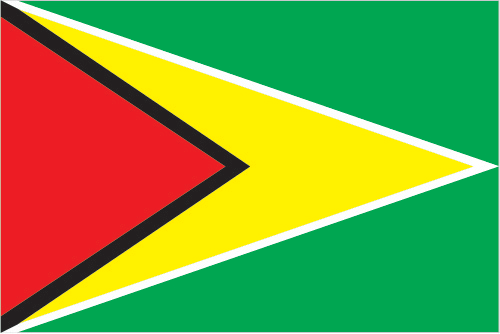Last updated on February 2nd, 2022
Guyana, officially the Co-operative Republic of Guyana, is a sovereign state on the northern mainland of South America. It is also the only Commonwealth state on mainland South America. With these facts about Guyana, let’s try to gain more information about its economy, people, geography, culture and history.
1. After Uruguay (176,215 square km) and Suriname (163,821 square km), Guyana (214,970 square km) is the third-smallest country on the mainland South America. Other South American countries are Brazil, Colombia, Argentina, Peru, Venezuela, Chile, Ecuador, Bolivia and Paraguay (total 12 countries).
These are the three dependent territories in South America:
- Falkland Islands (UK)
- French Guiana (France)
- South Georgia and the South Sandwich Islands (UK)
Map of South America

2. Guyana became independent on 26 May 1966 from the United Kingdom. The country’s population consists of people of various ethnicities including Chinese, Portuguese, East Indians, Europeans, Amerindians, and Africans who comfortably living alongside each other.
3. Interestingly, Guyana is also the only South American country where English is the official language. Official languages of other South American countries are:- Brazil – Portuguese; Venezuela – Spanish; Colombia – Spanish; Argentina – de facto Spanish; Peru – Spanish, Chile – Spanish; Ecuador – Spanish; Bolivia – Spanish and others; Paraguay – Spanish and Guarani; Suriname – Dutch; Uruguay – Spanish.
4. Guyana according to the English Oxford dictionary means “the land of many waters.”
5. The Dutch were the first to establish colonies in Guyana and later came the British.
6. Guyana has territorial disputes with both Venezuela and Suriname.
7. Guyana has three main geographical regions. One is a low lying coastal plain, the other is savannah zone, and the third is the mountainous region.
8. Guyana is also home to the world’s largest single drop waterfall – the Kaieteur Falls. The falls has a total length of 251 meters and it is amongst the most powerful waterfalls in the world with an average water flow rate of 663 cubic meters per second.

9. The Essequibo at 1,010 kilometres (628 mi) long, the Courantyne River at 724 kilometres (450 mi), the Berbice at 595 kilometres (370 mi), and the Demerara at 346 kilometres (215 mi) are the four longest rivers of Guyana.
10. About three-quarter of Guyana is forested. And of this area, 60% is considered as primary forest. Some parts of the rainforests in Guyana are almost inaccessible by humans. And the country has a low rate of deforestation.
11. Mount Roraima (Elevation: 2,810 m; First ascent: 1884) is the highest point in Guyana. It is surrounded by Venezuela and Brazil as well. However, the mountain’s highest point is Maverick Rock, which lies wholly within Venezuela. It rains almost every day on this flat-topped mountain.
Flag of Guyana

12. Guyana is divided into three counties: Essequibo, Demerara, and Berbice.
13. Despite the fact that Guyana has plenty of forest cover, its ancient soil is infertile and a majority of its populations lives in coastal areas.
14. For those living on the coast, farming and fishing is the main source of income.
15. Guyana also co-hosted the Cricket World Cup 2007 with the West Indies. It was during this World Cup matches played at the Providence Stadium that the Sri Lankan fast bowler Lasith Malinga became the first bowler in international cricket history to take four wickets in four consecutive balls. The stadium hosted six World Cup matches between March 28, 2007, and April 9, 2007.
16. According to the WHO, Guyana is ranked second in suicides per capita worldwide after Sri Lanka.
17. The largest mass suicide in modern history happened in Guyana when more than 900 people died in 1978. The people who died were the supporters of Jim Jones, the religious cult leader.
18. Since 1985, there has been an increase in diseases related to water and food consumption in Guyana. Despite the fact that at least 90% of the people living in rural and urban areas have access to clean drinking water.
19. Georgetown is the capital and chief port of Guyana.
20. New Amsterdam and Georgetown are the two main commercial centers of the country.
21. Wooden buildings are a part of the country’s legacy but they are fading now into the past with the arrival of concrete buildings that are more common.
22. Majority of the food is produced locally including vegetables, fruits, cooking oils, sugar, fish, meat, rum, and rice.
Map of Guyana
23. Export of sugar and rum is the main commercial activity in the country. Agriculture is a primary activity in the country and is a major contributor to its economy.
24. Arranged marriages are common among the Hindu and Muslim population of the country. Women are responsible for the upbringing of the children as the children are generally abandoned by their fathers.
25. In the recent years, more women than men in Guyana are attending university. Women are now playing a vital role in doing various jobs such as vendors, nurses, teachers, civil servants, market vendors, farmers, and clerks as well.
26. The proper upbringing of the children and their education is indispensable to the country’s culture. For inculcating moral values in the younger ones, people attend churches, mosques, and temples along with their children.
27. The University of Guyana was founded in 1963. It is also the place where many distinguished scholars and professionals have studied. It is the only one university in Guyana and higher education is very expensive for the local population.
28. US dollar is a widely accepted currency in Guyana.
29. Guyana experiences two rainy seasons: May to mid-August and mid-November to mid-January. During the rainy seasons, flash floods are a constant threat.
30. Spanish, Portuguese, Creole, and Amerindian languages are spoken in various parts of the country.
. . . continue reading on the next page
